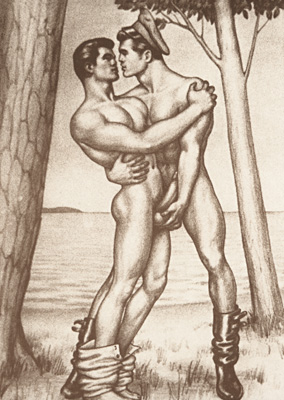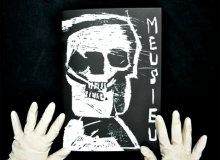| Umělec 2002/2 >> Grant Me a Wish, Tom of Finland | Просмотр всех номеров | ||||||||||||
|
|||||||||||||
Grant Me a Wish, Tom of FinlandUmělec 2002/201.02.2002 Tomáš Pospiszyl | focus | en cs |
|||||||||||||
|
Everybody knows what a man looks like. But to see a real man, all you have to do is take a look at several pictures by the king of gay esthetics.
A biker stands at a bar, leather cap, mustache, and under that a roguish smirk. His clothes are a little ragged, and his chest muscles rival a woman’s unwieldy breasts. In the leg-squeezing trousers we see all too clearly the anatomy of a giant penis. It’s length falls somewhere down to the mid-thigh range, and what’s more, at any moment this powerful erection is threatening to rip through the fabric of his trousers and fix its blind eye somewhere in the direction of the ceiling of the smoky bar. These are the kinds of men the now legendary Tom of Finland drew in his lifetime, who, for some, is the personification of gay kitsch, for others, a genius of male imagery. Journey through the classics Over the course of five decades his work mostly remained the same. He expressed himself with clear, realistic drawings, usually black and white. His work was typical for the stylized anatomy of his models, which were beefed up when necessary; however he never abandoned drawing or the comic strip format. His stories relate the adventures of love between men, with sometimes more and other times less humorous distance. But what has changed distinctly in the last half century is the public and the art community’s approach to his and similar works of art. Tom of Finland’s first works were made for a narrow and semi-illegal circle within the gay society. He lived long enough to see his work penetrate a wider society in the 1990s and eventually become objects collected by large museums. Exhibitions of his work are no longer limited to dark corners of porno shops, but now take place in galleries. The definition of art has widened and now accepts expressions like Tom’s drawings. Although at first sight it may seem improbable, Tom of Finland’s work is maybe closest to that of Norman Rockwell, the illustrator who commented on American society from the 1930s to the 1960s. Rockwell, considered by many the king of kitsch, was in reality a noteworthy artist who frequently expressed brave political opinions. He was able to transform the contradictions and paradoxes of the modern age into scenes of harmony and tolerance. The message of his work is simple: Difference is healthy, with a little tolerance there is space here for everyone. The settings and atmosphere of many of Tom’s scenes are in essence not so different from those of Norman Rockwell. He, too, was a great creator of harmony, capable of shinning the light of love and mutual understanding through even brutal sex. With his art out in the wider public, he put to the test a very simple question: What about his pictures could actually seem obscene to us? Be my Führer, Baby World War II, in which Tom was a soldier for the Finnish army, was an important period in the formation of his life and art. Early on he served with the anti-aircraft defense units in the capital city. More than anything, the war offered Tom a deluge of men in uniform and, after the signing of the German-Finnish contract of 1941, Helsinki was overflowing with elegant Nazis. From that time to the end of his life, he maintained the ideal of the masculine type of Nordic male. Tom began his rich sexual life as a fickle homosexual. The war for him was an opportunity to come into immediate contact with his idols in polished riding boots. The blackouts and power failures transformed the large city into an adventurous sexual playground and Tom took full advantage of all unexpected possibilities. In 1944 he was sent to the Finnish-Russian front in the Karelia region of Russia, where he killed a Russian soldier in a duel. With many others, he made love, and Tom never abandoned his love of uniforms. The discovery of motorcycle culture and rock’n’roll in the first half of the 1950s made a similar impact on him. Ultimately, men in leather looked very much like his ideal of maleness cultivated during his army years. Tom of Finland spent most of his life in Helsinki, where he made a living working in an advertising agency. Most people around him had no idea what he was about or that he was an artist. Thanks to his work, however, he traveled widely and came to know the life of the gay community throughout all of Europe, living for some time in Berlin, Hamburg, London and other gay centers. His drawings, which in the beginning were made only for certain delighted individuals or close friends, began to show up in print around the world and his name soon became a guarantee of quality. Michelangelo and Kenneth Anger Exactly how are gay esthetics defined? Understandably enough, no such definition exists. Tom of Finland acknowledged a number of artists, from whose works he drew inspiration. Of course his most important source was often anonymous pictures from pornographic magazines, which typically had no artistic ambition. Within a year he managed to gather together a large collection of material which also supplemented his own attempts at photography. But porn mags were not Tom’s only inspiration — he also drew from Soviet and Nazi propaganda posters, and a few initiatives were the result of Renaissance and Baroque art. He carefully studied the works of Michelangelo and Leonardo; some of his drawings are even variations on their figural compositions. The technical quality of Tom’s drawings is often overlooked. The more complicated compositions he worked out with the help of preliminary sketches, with special attention paid to details and features of the face. All of these preliminary studies ultimately led to drawings that surprise us with their lightness and confidence, hiding much of the preparatory work. A whole range of artists from the 20th century, whose works have only received attention in recent years, used an identical formula. The noteworthy American painter, Paul Cadmus (1904–1999), whose works were based on American realism from the 1930s, was Tom of Finland’s predecessor. This artist walked the line between official art and art designed only for the gay community his entire life. (See www.queer-arts.org/archives/9809cadmus/cadmus.html) The underground movies of Kenneth Anger are the film equivalent of Tom’s vision, especially his 1963 30-minute film about a motorcycle gang, Scorpio Rising. And even the pair Pierre et Gilles are successors to the lineage of art bequeathed to soft magazines specialized in culture and young men, whose images deliberately rest on the boundary between high art and kitsch and are enriched through the mixing of various elements of world culture. Even Gays Celebrate Christmas If we flip through hundreds of Tom’s drawings, we discover that their appearance and titles don’t change all that much. It’s difficult to speak here about monotony or even about repeating your own ideas. If, according to some viewers, Tom of Finland repeats stereotypes or even homoerotic cliches, then every picture of Christ is a Christian cliche. Above all, his work is clearly defined and concentrated. Tom of Finland is the creator of several iconography forms that unfurl in his work through tireless variations. He also takes over the many icons of masculinity that have long appeared in gay art, such as the lumberjack, sailor, soldier or the inexperienced boy. To these he adds his policemen and bikers, and in 1962 the erotic figure of Santa Clause came out for the first time, becoming one of his most successful and sought after figures. The next symbol of masculinity, the construction worker, appeared in the 1970s and became one of the homosexual archetypes of the ideal community that was the disco sensation The Village People. From the 1970s the possibilities in his drawings increased and began to include black men, which up to then had made only the rare appearance in Tom’s world. Tom of Finland gradually came to rule over a whole range of figures and roles with endless variations among them and used in numberless mutual combinations. The sailor and wharf subculture at the end of the 20th century began to slowly disappear, but in the 1980s the sailor made a comeback in Tom’s work. However this time he was a symbol of the past, the good old days in Hamburg, but also in memory of the premature death of his friend Veli. The character of Kake, the hero of many simple comic stories, has a special place in Tom’s work. Kake is a mustached young man who never refuses an invitation to a sexual romp. His tales are full on fornication and humor, intercourse being for him the one worthwhile sport on earth. This forever horny lad is the symbol of healthy and joyful sex, whose partners, after the fun is over, go their merry way with a friendly handshake and without ever really knowing if in the future they will see each other again. What men dream about Even though some of Tom of Finland’s pictures depict sadomasochistic practices, all of his work is saturated with his brand of kindness. We see a young man’s huge penis that could never, under any circumstances, cram itself into any anus, however well you’ve greased it up. But at the same time we know that the owner of this giant instrument will make thoughtful progress in bringing both him and his partner much delight. No matter what brutal thrusting is going on, friendly trust is never taken advantage of. The world of Tom of Finland is a world of consensual sex and mass love, natural as breathing. All participants in his sexual scenes take great pleasure from their own conduct, and are satisfied with themselves. True love knows no taboos; everything is admissible, natural and positive. Unlike standard pornography, Tom’s characters are not merely the figments of someone’s imagination, and they don’t serve only to slake the lust of one party. All are active participants in the mutual sex act where it is possible and natural to swap roles. Pictures depict a whole network of mutually intertwining relationships lacking any standard hierarchy. The basic rule is simple: Anyone who fucks can, at the same time, be fucked. The relationship of Tom’s world to women is peculiar. Women are rare in his pictures, though they do show up. Some of them only serve to fulfil the cliche of the frolicking vixen that won’t let the real boys only play with each other. They personify a moralizing element that cannot comprehend basic male desire. However women can also take part in orgies as full-fledged participants. Even though Tom’s drawings are teeming with mammoth cocks and gouts of semen, maybe the most erotic images are the ordinary portraits of young men. Tom was able to catch this love-brimming relationship to the mostly anonymous men, whose portraits his lovers would let him draw up from their photographs. You see, Tom of Finland was not merely a pornographer or an artist forever in love who solved all his problems and frustrations through his work. His art reaches across the borders of personal inclination and gay subculture. He is the creator of a unique world of friendship, male solidarity and joy from which anyone can take something, regardless of denomination, age or sexual orientation.
01.02.2002
Рекомендуемые статьи
|
|||||||||||||
|
04.02.2020 10:17
Letošní 50. ročník Art Basel přilákal celkem 93 000 návštěvníků a sběratelů z 80 zemí světa. 290 prémiových galerií představilo umělecká díla od počátku 20. století až po současnost. Hlavní sektor přehlídky, tradičně v prvním patře výstavního prostoru, představil 232 předních galerií z celého světa nabízející umění nejvyšší kvality. Veletrh ukázal vzestupný trend prodeje prostřednictvím galerií jak soukromým sbírkám, tak i institucím. Kromě hlavního veletrhu stály za návštěvu i ty přidružené: Volta, Liste a Photo Basel, k tomu doprovodné programy a výstavy v místních institucích, které kvalitou daleko přesahují hranice města tj. Kunsthalle Basel, Kunstmuseum, Tinguely muzeum nebo Fondation Beyeler.
|








































 New book by I.M.Jirous in English at our online bookshop.
New book by I.M.Jirous in English at our online bookshop.
Комментарии
Статья не была прокомментированаДобавить новый комментарий